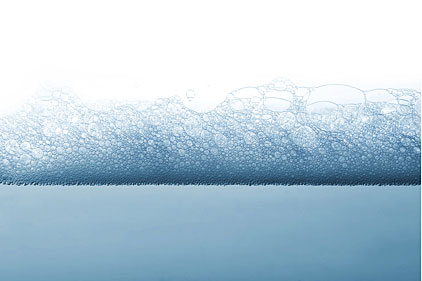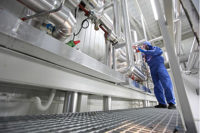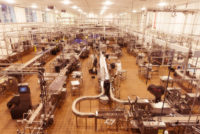It’s hard to imagine Clean-in-Place systems without the, well, cleaning agents. But some processors are taking another look at the 1970’s Soviet-developed electro-chemically activated (ECA) water systems to harness water’s properties to do the dirty work of cleaning without using harsh chemicals.
ECA technology converts food grade salt and soft water into cleaning agents. First, the salty water is run through patented reactors located within device cabinets — in the case of some equipment manufacturers — before being zapped with an electrical charge. This charge creates two solutions: the disinfectant, anolyte, and the detergent, catholyte. The once-salty water can now be used to clean machines, carcasses and other foods and beverages.
“ECA water has a lot of potential because it can reduce the handling dangers of chemicals in the clean-in-place [CIP] process,” says Tim Bowser, Ph.D., food process engineer at Oklahoma State University, in Stillwater, Okla.
As with any new technology, ECA water carries with it a higher upfront cost. “But this extra cost can be offset by energy savings, less chemical expenses, storage and handling dangers,” he says.
Ozone systems have also been touted as a safer, less expensive but more effective cleaning and disinfecting agent. Ozone can replace potentially harmful chemicals as an environmentally friendly disinfectant that is 10 times stronger than chlorine, with no residue or byproducts after the disinfecting process. Also, ozone use cuts down on the number of hot water cycles, which saves energy costs and the amount of water used.
However, “ozone systems have been in use for years but never to a great extent,” says John Johnson, managing director of Epsilon Industries, in Sioux City, Iowa. “The ozone has a ‘quick’ shelf life.”
Other innovations in clean-in-place technology are using valves with rotating internal CIP spray heads for more effective cleaning, on-demand CIP systems with quicker, more accurate blending, verification systems for rotating spray devices and process automation advances like data analytics, says Bowser.
Nuts and bolts of safety
“I think the biggest improvement has been with the plant and equipment designs that allow more efficient cleaning and better food safety,” says Johnson. “Open designs and easier access to hidden areas has significantly improved the sanitation process along with food safety.”
Bowser says automation systems have also seen major improvements over the years with faster and better control schemes, improved sensors and monitoring and better hardware-human interface through wireless handheld enabled devices.
“The FSMA (Food Safety Modernization Act) has done a lot to move hardware toward better cleanability and sanitary status,” Bowser says. “New seal and gasket materials have made tremendous advances in compatibility, temperature and strength. Many can now be detected in a metal detector.”
In addition, advanced cutting, shaping and materials joining techniques have improved stainless steel fabrication, along with quality and supply.
“3-D printing will soon have a major impact on food equipment manufacturing and food processing,” as well, Bowser notes.
Going beyond water
Certainly there are always process improvements with any system, including CIP.
“When looking at the process, all aspects need to be evaluated as a whole and not separated such as costs, chemical effectiveness and environmental impact,” says Johnson. “When looking at any cleaning process, the process to improve will evolve with technology to deliver the most efficient and effective food safety platform.”
Try cleaning without water, too. The move to reduce and eventually eliminate water in CIP systems is underway because of the threat of future water shortages and energy conservation, but that will be a tall order.
“Water is a universal solvent and works perfectly, but takes effort to recover [through energy and filtration], is a potential pollutant and takes up quite a bit of space, especially during wastewater treatment,” Bowser says.
Some other challenges are converting older equipment and facilities to CIP compatibility, developing comprehensive CIP standards for an ever-expanding list of new equipment and creating CIP methods for plant and facility spaces, Bowser says.
Manufacturers are also working on speeding up CIP cycles with deeper integration into plant operations, understanding properties of food contact surfaces (for example, the roughness and coatings with respect to cleaning and microbiology or corrosion resistance), reduction of waste materials resulting from CIP and validation of CIP operations, says Bowser.
“And there is still a lot to learn about the chemistry of soils and surfaces to create new and effective methods to remove stubborn soil and scale on food contact surfaces,” he says, or prevent soil from attaching in the first place.
With some changes in surface chemistry, fats and microbes won’t attach to surfaces.
That may be the next phase for clean-in-place systems: self-cleaning inside and out.





Report Abusive Comment